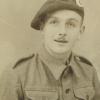When 16th Independent Parachute Brigade Group was sent to Cyprus in preparation for the Suez operation (Op Musketeer), it was realised that 33rd Parachute Field Regiment would not be able to provide close artillery support to any parachute assault because it was equipped with 25 pdrs. These could only be dropped by air using the medium stressed platform which at that time could only be dropped from the C 119 aircraft of the USAF who were definitely not going to play ball.
Artillery support could therefore only be provided by the Royal Navy. Consequently Capt Darrell Hall of 96 Bty and Capt Alan Steptoe of 97 Bty with their OP parties were sent to Malta to be trained as Naval Gunfire Forward Observers. When the parachute assault took place on 5 November 1956 Capt Hall jumped with the French while Capt Steptoe jumped with 3 PARA taking with him my troop leader, Lieut Tom Fletcher, as back up.
The seaborne landings were to have coincided with the airborne drop but at the last minute the latter was brought forward by 24 hours. As a result the destroyers of the naval task force were not in range to provide fire support. Instead, the strike aircraft of the Fleet Air Arm formed a cab rank over the DZ to provide support on call.
Subsequently the 25 pdr was deemed unsuitable for airborne service and early in 1957 the regiment was re-equipped with the 4.2” mortar becoming 33rd Parachute Light Regiment. But with its limited range of 4,100 yards, it was impossible to provide any depth to the fire support for the Brigade. Such support could only be provided by closely integrated ground attack aircraft. To this end the Parachute Air Contact Teams (Para ACTs) were established and the Royal Artillery was asked to man the officer posts. The first team was formed by Capt Darrell Hall and Lt Neville Morris, the second by Capt Mike Darmody and Lt Nick Jones.
Each team had a RA driver/operator and a small Royal Signals detachment to maintain a dedicated air request net. Each officer was trained as a forward air controller. This was his primary role but he brought with him his experience as a FOO/NGSFO. Each team was equipped with A43, C42, C45 and D11 radios. This excellent radio mix gave the team the ability to coordinate fire support across the battle group area especially when there was a need for deconfliction. Although they did not have the array of weaponry available to today’s soldier, they were without doubt fire support teams in modern parlance.
I was OC of 2 Para ACT in support of 1 and 3 PARA in the Gulf and in the Radfan in 1965 and 1966. I handed over to Lt John Webb, previously of 95th Amphibious Observation Regiment, in Bahrain. However I do not know the date of the demise of the ACTs but I suspect that it coincided with the end of the Parachute Brigade to the Gulf.
By Lt Col Derek Reavill
Read More




Latest Comments
There are currently no comments for this content.
Add Comment
In order to add comments you must be registered with ParaData.
If you are currently a ParaData member please login.
If you are not currently a ParaData member but wish to get involved please register.